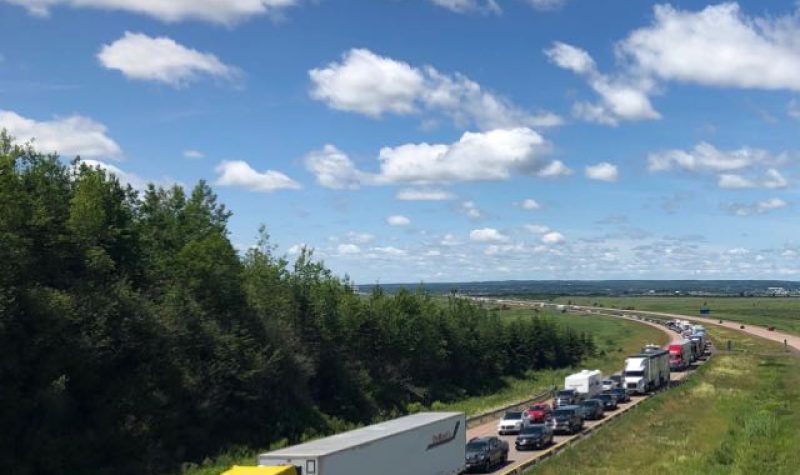When Joanna Perkin gets in her car to drive home to New Brunswick after a 12-hour shift at the Amherst women’s shelter where she works, she never knows how long the trip will take.
While her drive home usually takes about 15 minutes, she can be stuck at the border for an extra hour or more.
Click to listen:
“After my long shift, I want to get home. And instead, when I’m leaving work, I’m making sure that I have a snack in the car, I’m making sure I’ve used the bathroom, I’m making sure I’ve filled my water bottle up, because I don’t know how long I’m going to be waiting at the border. Making sure that my phone is charged, all of those things. Like you know, sitting in my car and watching people get out and sit on the side of the road or getting out and urinating on the side of the road getting into New Brunswick. It’s really ridiculous to watch and to be a part of that, right?”
Perkin has had no trouble getting into Nova Scotia on her way to work, but getting home to New Brunswick is a different story.
And it all started with the Atlantic bubble.
Click to listen:
“So going across the border when it was shut, I had passes to get both into Nova Scotia and New Brunswick and had no challenges with that for the however many months that the borders were closed. Since the Atlantic bubble has opened on I think it was July 3, I have had every challenge that I can imagine getting back into my home province of New Brunswick. I still have zero challenges going across into Nova Scotia.”
Perkin says she has never been refused or turned away at the border, but she has gotten mixed messages about the process.
And what’s most frustrating, she says, the erratic wait times often seem pointless.
Click to listen:
“More often than not, I’ve been waved through. But it’s not because I have a pass. It’s because they’re waving everybody through. So last night, I sat in line for about 35 minutes. And then they just let every car go through. They weren’t checking anybody. There was nobody even waving them through. All the border workers were just sitting in their little tents that they have set up there, and everybody was just driving through.“
Another point of confusion for Perkin is the status of her essential workers pass.
Despite being assured by the premier’s office that the pass will not expire, she has been told several times by border staff that it has.
Others have told her to hang on to it no matter what.
Perkin has yet to use the new online pre-registration form put in place two weeks ago by the New Brunswick government, which it claimed would help speed up things at the border.
If anything, things have gotten worse since then, says Perkin.
She says there’s no point to using the online form.
Ciick to listen:
“I’ve actually said to the Premier’s office, I really have no intention of registering online. And that sounds like I’m being difficult, but it’s because it’s changed so many times. And it doesn’t matter whether I’m registered or not, I still have to wait in that line up at the border. There’s no separate line for people who have their forms filled out already. So it doesn’t matter whether I do it in advance or not. And at the border I’m being told I don’t need to fill it out because I have an essential worker pass.”
Perkin would like to see essential workers given access to the commercial vehicle lane, a second lane set aside for trucks or other commercial vehicles crossing the border.
She’d also like to see New Brunswick work with its neighbouring province to relocate the border checkpoint to the weigh station in Nova Scotia, with its many available lanes.
Perkin has shared her issues with MLA Megan Mitton, Sackville mayor John Higham and even Nova Scotia MLA Elizabeth Smith-Mccrossin.
All have been helpful, she says, but unable to cause change.
Click to listen:
“In terms of people who actually make the decisions about what’s going to happen at the border, I’ve been really bounced around. Oh, you should talk to this person. You should talk to this person. Oh, just fill out the form online and it’ll be fine. Well, the form doesn’t do anything for me at the border, first of all. And being bounced around from person to person… Somebody has to be making the decisions, right? So I’ve been having like a lot of a lot of difficulty. I haven’t really received any satisfactory response in terms of what they are going to do to make this easier and less complicated.”
What the government needs to do, says Perkin, is figure out the goal of the border policy, and then put consistent measures in place that can achieve that.
Click to listen:
“The big thing is that they need to be consistent in whatever they’re doing. They need to figure out what they’re going to do and stick with it.”
CHMA has reached out to the New Brunswick Department of Public Safety for more information, and we’ll bring you that in the coming days.
If you have issues or questions with the border, please contact CHMA news at news@chmafm.com


